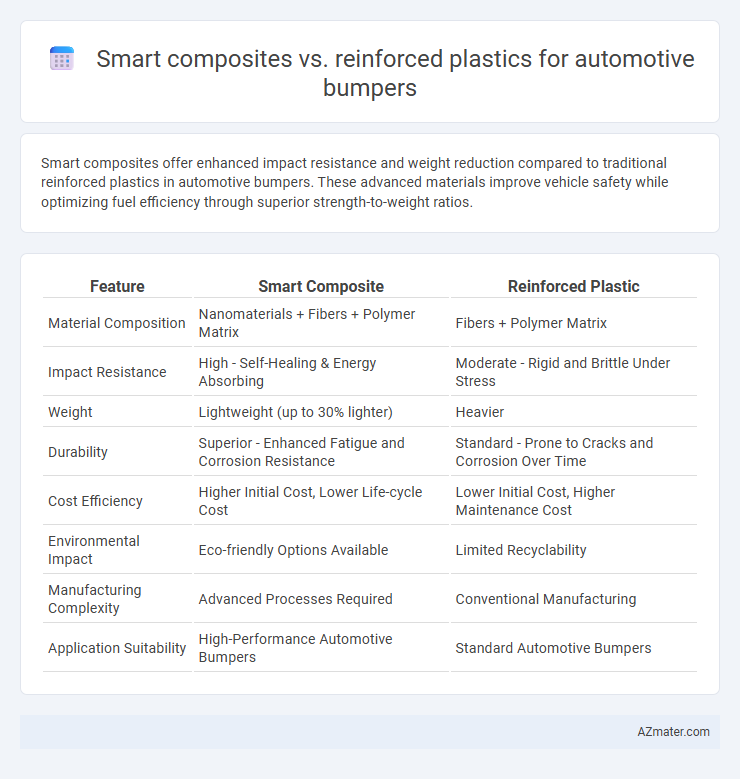Smart composites offer enhanced impact resistance and weight reduction compared to traditional reinforced plastics in automotive bumpers. These advanced materials improve vehicle safety while optimizing fuel efficiency through superior strength-to-weight ratios.
Table of Comparison
| Feature | Smart Composite | Reinforced Plastic |
|---|---|---|
| Material Composition | Nanomaterials + Fibers + Polymer Matrix | Fibers + Polymer Matrix |
| Impact Resistance | High - Self-Healing & Energy Absorbing | Moderate - Rigid and Brittle Under Stress |
| Weight | Lightweight (up to 30% lighter) | Heavier |
| Durability | Superior - Enhanced Fatigue and Corrosion Resistance | Standard - Prone to Cracks and Corrosion Over Time |
| Cost Efficiency | Higher Initial Cost, Lower Life-cycle Cost | Lower Initial Cost, Higher Maintenance Cost |
| Environmental Impact | Eco-friendly Options Available | Limited Recyclability |
| Manufacturing Complexity | Advanced Processes Required | Conventional Manufacturing |
| Application Suitability | High-Performance Automotive Bumpers | Standard Automotive Bumpers |
Introduction: Evolution of Automotive Bumper Materials
Automotive bumpers have evolved from simple metal structures to advanced materials like smart composites and reinforced plastics, enhancing impact absorption and weight reduction. Smart composites integrate sensors and adaptive features for improved safety and performance, while reinforced plastics offer high strength-to-weight ratios and corrosion resistance. These innovations reflect the industry's shift towards lightweight, durable, and intelligent bumper systems to meet stringent safety and environmental standards.
Defining Smart Composites and Reinforced Plastics
Smart composites are advanced materials integrating sensors or actuators within fiber-reinforced matrices to enable self-sensing, damage detection, or adaptive response in automotive bumpers, enhancing safety and durability. Reinforced plastics, commonly used in automotive bumpers, consist of polymer matrices reinforced with fibers like glass or carbon to improve mechanical strength and impact resistance without embedded smart functionalities. The key distinction lies in smart composites' ability to interact dynamically with their environment, while reinforced plastics primarily provide structural support and energy absorption.
Material Composition and Structural Differences
Smart composites for automotive bumpers typically incorporate advanced materials such as carbon fiber-reinforced polymers combined with sensors or nano-enhanced resins, providing superior strength-to-weight ratios and adaptive impact resistance. Reinforced plastics generally consist of glass fiber or aramid fiber embedded in a thermoset or thermoplastic matrix, offering durable structural support but with less flexibility and integration capabilities. The structural difference lies in smart composites' multifunctional layers and responsiveness compared to the static reinforcement of traditional fiber-reinforced plastic bumpers.
Impact Resistance: Performance Comparison
Smart composites exhibit superior impact resistance in automotive bumpers compared to reinforced plastics due to their enhanced energy absorption and damage tolerance properties. Reinforced plastics, while strong and lightweight, typically show lower impact resistance and higher susceptibility to cracking under sudden force. Advanced smart composite materials integrate sensors and adaptive features, further improving durability and safety during collisions.
Weight Reduction and Fuel Efficiency
Smart composite materials used in automotive bumpers offer significant weight reduction compared to traditional reinforced plastics, typically achieving up to 30% lighter structures. This weight savings directly enhances fuel efficiency by reducing the overall vehicle mass, leading to lower fuel consumption and decreased CO2 emissions. Advanced smart composites also provide superior impact resistance and durability, maintaining safety standards while optimizing performance and sustainability in automotive design.
Cost Analysis: Manufacturing and Lifecycle Expenses
Smart composites for automotive bumpers offer a higher initial manufacturing cost compared to reinforced plastics due to advanced materials and processing techniques. Lifecycle expenses favor smart composites through enhanced durability, reduced maintenance, and improved impact resistance, leading to lower replacement rates. Reinforced plastics provide cost advantages in mass production with simpler fabrication but may incur higher long-term repair and replacement costs.
Environmental Sustainability: Recycling and End-of-Life
Smart composites in automotive bumpers offer enhanced environmental sustainability through improved recyclability and reduced waste compared to reinforced plastics, which often present challenges due to mixed material layers and adhesives. The design of smart composites facilitates easier separation and processing at end-of-life, promoting circular economy practices and lowering landfill contributions. Incorporating bio-based matrices and recyclable fibers in smart composites further decreases carbon footprint and supports regulatory compliance in automotive manufacturing.
Integration with Sensor and Safety Technologies
Smart composites in automotive bumpers offer superior integration capabilities with sensors and advanced safety technologies due to their customizable fiber orientations and embedded sensing elements, enhancing real-time impact detection and energy absorption. Reinforced plastics provide basic structural strength but lack the inherent adaptability for embedding complex sensor networks, often requiring additional components that can increase weight and compromise design flexibility. Consequently, smart composites deliver a more efficient, lightweight solution for integrating active safety features, improving collision response and passenger protection.
Real-world Case Studies and Applications
Smart composites in automotive bumpers demonstrate superior impact resistance and energy absorption compared to traditional reinforced plastics, as evidenced by crash test data from leading manufacturers like BMW and Tesla. Real-world case studies highlight smart composites' lightweight properties contribute to improved fuel efficiency and reduced emissions without compromising safety standards. Applications within automotive design reveal that smart composites enable enhanced customization and integration of sensing technologies, outperforming reinforced plastics in durability and functional performance.
Future Trends in Automotive Bumper Materials
Smart composites for automotive bumpers incorporate embedded sensors and adaptive materials that enhance impact resistance and enable real-time damage detection, marking a significant advancement over traditional reinforced plastics. Reinforced plastics, composed mainly of glass or carbon fibers, offer high strength-to-weight ratios but lack the dynamic functionality of smart composites. Future trends indicate a strong shift towards integrating smart composite materials to improve bumper performance, reduce vehicle weight, and facilitate predictive maintenance in automotive safety systems.

Infographic: Smart composite vs Reinforced plastic for Automotive bumper
 azmater.com
azmater.com